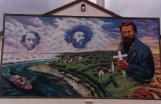37
Mural of the major players of the 1885 Uprising.9 December 2003
This mural is on the curling rink on Victoria Street in Duck Lake, Saskatchewan

38
"The Prophet" reflects the individduals who had the greatest influence in the 1885 Uprising. Former Prime Minister, John A. MacDonald, who was the demise of Riel, Gabriel Dumont, a strong force and supporter of Riel and Louis Riel, the Man of Hope to the Métis people. These three people are superimposed onto the site of Batoche. The four seasons, fall, winter, spring and summer are used to underline the importance of the characters to the Uprising.John A. MacDonald's portrait is engulfed in winter, and as an Easterner, he is depicted as cold and indifferent to the concerns of the Métis in the West. MacDonald represents the coldness of the law of the day.
Gabriel Dumont is looking to the distance as if searching for an answer. His figure starts to emerge from spring as he looks toward Louis Riel for leadership and some glimmer of hope.
As summer and fall approach, Louis Riel looks to us all. Riel is painted in flesh colour as he lives on today in many of our minds and, certainly, in the minds of his people - The Métis. He holds a cross representing his strong beliefs in his religion and his concerns for his people. Louis Riel considered himself a "Prophet", signing his name as Louis "David" Riel. Fall has arrived and the scenery behind Riel is gloomy as this was the season when he was hanged. The cross in the painting grows from the cemetery and joins the church. In this cemetery are buried the people who's strong faith led them to fight for their beliefs.
This mural was painted by German Jaramillo, a Saskatchewan resident, and can be seen on the curling rink in Duck Lake, Saskatchewan, Canada.